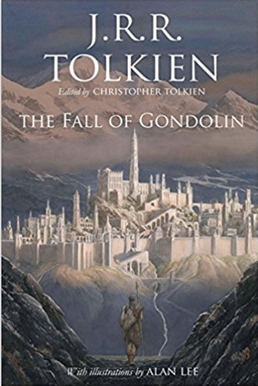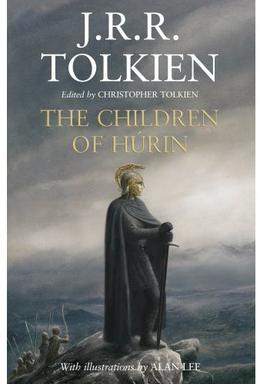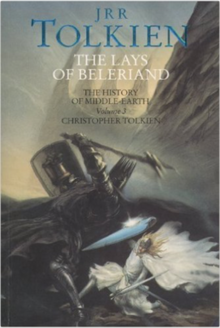
Christopher John Reuel Tolkien was an English and naturalised French academic editor. The son of author and academic J. R. R. Tolkien, Christopher Tolkien edited much of his father's posthumously published work, including The Silmarillion and the 12-volume series The History of Middle-Earth. Tolkien also drew the original maps for his father's The Lord of the Rings.
Eärendil the Mariner and his wife Elwing are characters in J. R. R. Tolkien's Middle-earth legendarium. They are depicted in The Silmarillion as Half-elven, the children of Men and Elves. He is a great seafarer who, on his brow, carried the morning star, a jewel called a Silmaril, across the sky. The jewel had been saved by Elwing from the destruction of the Havens of Sirion. The morning star and the Silmarils are elements of the symbolism of light, for divine creativity, continually splintered as history progresses. Tolkien took Eärendil's name from the Old English name Earendel, found in the poem Crist A, which hailed him as "brightest of angels"; this was the beginning of Tolkien's Middle-earth mythology. Elwing is the granddaughter of Lúthien and Beren, and is descended from Melian the Maia. Through their progeny, Eärendil and Elwing became the ancestors of the Númenorean, and later Dúnedain, royal bloodline.

Fëanor is a fictional character in J. R. R. Tolkien's The Silmarillion. He creates the Tengwar script, the palantír seeing-stones, and the three Silmarils, the skilfully-forged jewels that give the book their name and theme, triggering division and destruction. He is the eldest son of Finwë, the King of the Noldor Elves, and his first wife Míriel.
In J. R. R. Tolkien's fictional legendarium, Beleriand was a region in northwestern Middle-earth during the First Age. Events in Beleriand are described chiefly in his work The Silmarillion, which tells the story of the early ages of Middle-earth in a style similar to the epic hero tales of Nordic literature, with a pervasive sense of doom over the character's actions. Beleriand also appears in the works The Book of Lost Tales, The Children of Húrin, and in the epic poems of The Lays of Beleriand.
Lúthien and Beren are characters in J. R. R. Tolkien's fantasy world Middle-earth. Lúthien is an elf, daughter of the elf-king Thingol and goddess-like Melian. Beren is a mortal man. The complex tale of their love for each other and the quest they are forced to embark upon is a story of triumph against overwhelming odds but ending in tragedy. It appears in The Silmarillion, the epic poem The Lay of Leithian, the Grey Annals section of The War of the Jewels, and in the texts collected in the 2017 book Beren and Lúthien. Their story is told to Frodo by Aragorn in The Lord of the Rings.

Elu Thingol or Elwë Singollo is a fictional character in J.R.R. Tolkien's Middle-earth legendarium. He appears in The Silmarillion, The Lays of Beleriand and The Children of Húrin and in numerous stories in The History of Middle-earth. The King of Doriath, King of the Sindar Elves, High-king and Lord of Beleriand, he is a major character in the First Age of Middle-earth and an essential part of the ancestral backgrounding of the romance between Aragorn and Arwen in The Lord of the Rings. Alone among the Elves, he married an angelic Maia, Melian.
Túrin Turambar is a fictional character in J. R. R. Tolkien's legendarium. Turambar and the Foalókë, begun in 1917, is the first appearance of Túrin in the legendarium. Túrin is a Man of the First Age of Middle-earth, whose family had been cursed by the Dark Lord Morgoth. While trying vainly to defy the curse, Túrin brings ruin across much of Beleriand, and upon himself and his sister Niënor. His title, "Turambar", means master of fate.
Tuor Eladar and Idril Celebrindal are fictional characters from J. R. R. Tolkien's Middle-earth legendarium. They are the parents of Eärendil the Mariner and grandparents of Elrond Half-elven: through their progeny, they become the ancestors of the Númenóreans and of the King of the Reunited Kingdom Aragorn Elessar. Both characters play a pivotal role in The Fall of Gondolin, one of Tolkien's earliest stories; it formed the basis for a section in his later work, The Silmarillion, and was expanded as a standalone publication in 2018.

Nightfall in Middle-Earth is the sixth studio album by the German power metal band Blind Guardian. It was released on 28 April 1998 through Virgin Records. It is a concept album based on J. R. R. Tolkien's The Silmarillion, a book of tales from the First Age of Middle-earth, recounting the troubled history of Beleriand as the Elves battle with the Dark Lord Morgoth. The album contains not only songs but also spoken parts narrating parts of the story. The cover depicts a scene from The Silmarillion, the elf Lúthien dancing in front of the Dark Lord Morgoth.
Húrin is a fictional character in the Middle-earth legendarium of J. R. R. Tolkien. He is introduced in The Silmarillion as a hero of Men during the First Age, said to be the greatest warrior of both the Edain and all Men in Middle-earth. His actions, however, bring catastrophe and ruin to his family and to the people of Beleriand.

The Book of Lost Tales is a collection of early stories by the English writer J. R. R. Tolkien, published as the first two volumes of Christopher Tolkien's 12-volume series The History of Middle-earth, in which he presents and analyses the manuscripts of those stories, which were the earliest form of the complex fictional myths that would eventually comprise The Silmarillion. Each of the Tales is followed by notes and a detailed commentary by Christopher Tolkien.

J. R. R. Tolkien's The Fall of Gondolin is one of the stories which formed the basis for a section in his posthumously-published work The Silmarillion, with a version later appearing in The Book of Lost Tales. In the narrative, Gondolin was founded by King Turgon in the First Age; the city was carefully hidden, enduring for centuries before being betrayed and destroyed.
The following outline is provided as an overview of and topical guide to the real-world history and notable fictional elements of J. R. R. Tolkien's fantasy universe. It covers materials created by Tolkien; the works on his unpublished manuscripts, by his son Christopher Tolkien; and films, games and other media created by other people.

Beren and Lúthien is a compilation of multiple versions of the epic fantasy Lúthien and Beren by J. R. R. Tolkien, one of Tolkien's earliest tales of Middle-earth. It is edited by Christopher Tolkien. It is the story of the love and adventures of the mortal Man Beren and the immortal Elf-maiden Lúthien. Tolkien wrote several versions of their story, the last in The Silmarillion, and the tale is also mentioned in The Lord of the Rings at the council of Elrond. The story takes place during the First Age of Middle-earth, about 6,500 years before the events of The Hobbit and The Lord of the Rings.

The Children of Húrin is an epic fantasy novel which forms the completion of a tale by J. R. R. Tolkien. He wrote the original version of the story in the late 1910s, revising it several times later, but did not complete it before his death in 1973. His son, Christopher Tolkien, edited the manuscripts to form a consistent narrative, and published it in 2007 as an independent work. The book is illustrated by Alan Lee. The story is one of three "great tales" set in the First Age of Tolkien's Middle-earth, the other two being Beren and Lúthien and The Fall of Gondolin.
This is a list of all published works of the English writer and philologist J. R. R. Tolkien. Tolkien's works were published before and after his death.

The Silmarillion is a collection of myths and stories in varying styles by the English writer J. R. R. Tolkien. It was edited and published posthumously by his son Christopher Tolkien in 1977, assisted by the fantasy author Guy Gavriel Kay. It tells of Eä, a fictional universe that includes the Blessed Realm of Valinor, the ill-fated region of Beleriand, the island of Númenor, and the continent of Middle-earth, where Tolkien's most popular works—The Hobbit and The Lord of the Rings—are set. After the success of The Hobbit, Tolkien's publisher, Stanley Unwin, requested a sequel, and Tolkien offered a draft of the writings that would later become The Silmarillion. Unwin rejected this proposal, calling the draft obscure and "too Celtic", so Tolkien began working on a new story that eventually became The Lord of the Rings.
The poetry in The Lord of the Rings consists of the poems and songs written by J. R. R. Tolkien, interspersed with the prose of his high fantasy novel of Middle-earth, The Lord of the Rings. The book contains over 60 pieces of verse of many kinds; some poems related to the book were published separately. Seven of Tolkien's songs, all but one from The Lord of the Rings, were made into a song-cycle, The Road Goes Ever On, set to music by Donald Swann. All the poems in The Lord of the Rings were set to music and published on CDs by The Tolkien Ensemble.











